The Coevolutionary Arms Race: Fungus-Growing Ants and Social Parasites
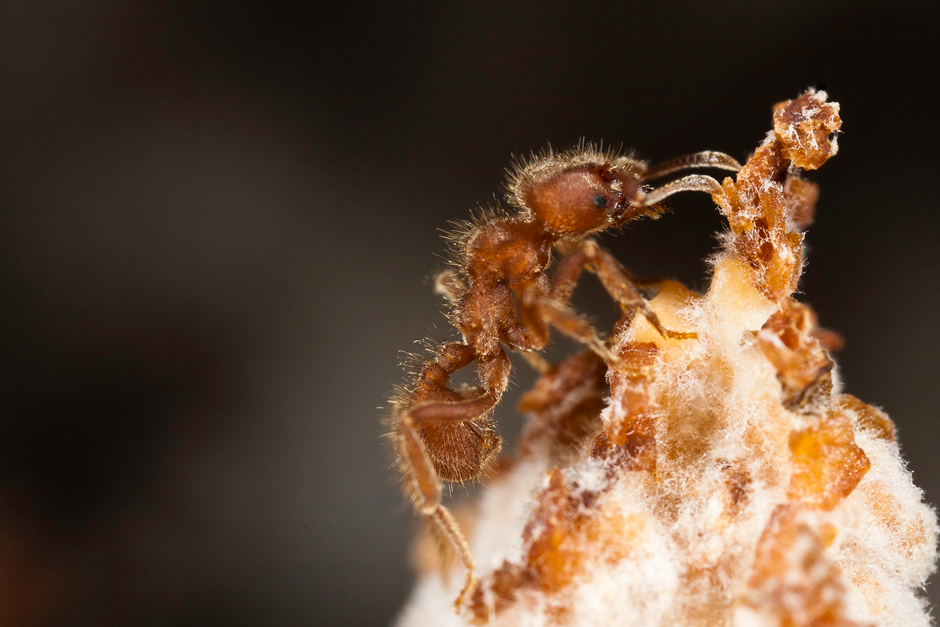 Sericomyrmex amabilis farmer ant worker atop her fungus garden. This species is host to guest ant social parasite,
Sericomyrmex amabilis farmer ant worker atop her fungus garden. This species is host to guest ant social parasite,Megalomyrmex symmetochus (Credit: Anders IlIum)
Despite the negative stereotypes surrounding social parasites, Rachelle Adams, Assistant Professor at The Ohio State University, knows just how important host-parasite relationships are to evolution. Like many ecologists, Adams, Assistant Professor at The Ohio State University, found her passion for nature in childhood. “It began when I was a kid. I had this general interest of nature, and I loved to spend time in the forest, exploring,” she recalls. Her desire to work with wildlife was solidified in college. “I didn’t know exactly what direction I was going to head in but the ecology and evolution classes I took were really central to shifting my perspective on ‘what is biology.’ It opened my eyes to seeing nature in a different way,” she explains.
Adams’ interests zoned in during her undergraduate research focusing on species interactions and social behavior. And while insects may not be the first social creature that comes to mind, Adams saw just how important communication was to insect behaviors and interactions. She elaborates, “That hands-on research experience really impacted the direction that I went.”
Even still, insects might not seem like the most obvious research subject. “I started as an undergraduate researcher studying honeybees and–I’ve always loved animals, but I’d never thought about insects until I got to college. So, I’m not an example of somebody who loved ants when they were a kid, instead my interest in insects and behavior were formed as a result of my research on honey bees,” explains Adams.
The buzzing social lives of the bees she observed during her undergraduate years charmed Adams into pursuing a career studying bugs. During her time in the honey bee lab, Adams realized that “insects have amazing, complex social behaviors—they’re also really fuzzy and cute,” making her future career as a researcher clear.
The journey from bees to fungus-growing ants was an easy transition made during her time as a research technician at the Smithsonian and the University of Maryland, wherein her research focused on ant evolution. It was during this time that she connected evolution with the social behaviors that she’d found so fascinating when observed in bees. “The ants have interesting, complex social behaviors, but also have a mutualistic relationship with their fungus garden,” she explains.
From an evolutionary perspective, it’s interesting to observe how ants have adapted to their habitat and coevolved in symbiotic relationships. The fungus garden relies on the ants for growth as much as the ants rely on the garden for food. This relationship becomes more complicated when observing the interjection of social parasites and how they have coevolved alongside the fungus garden and its caretakers.
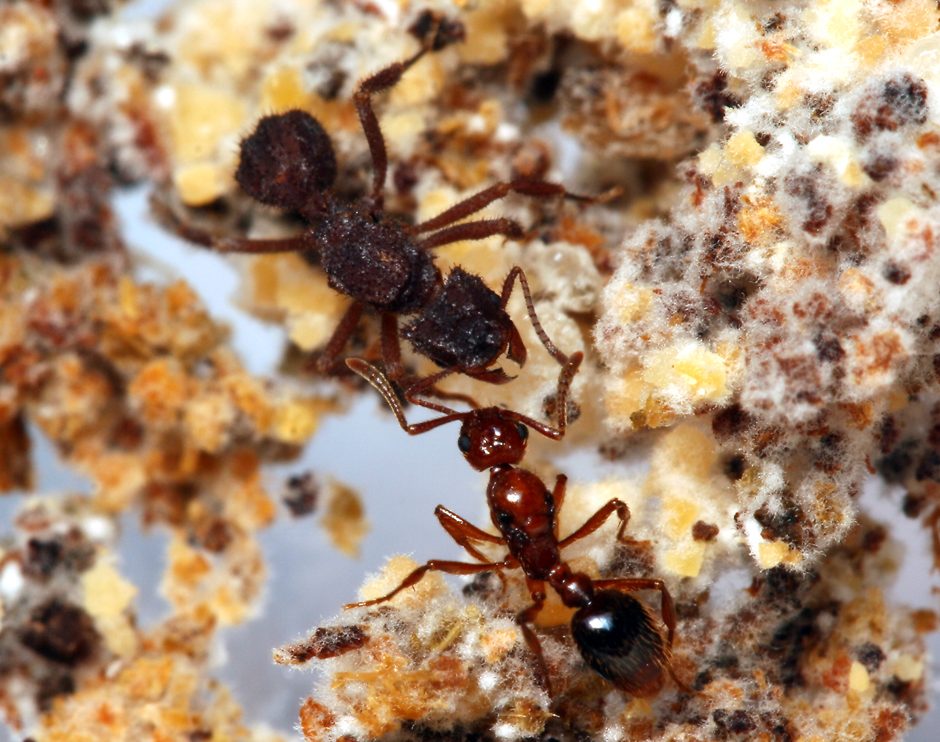
Mycetomoellerius mikromelanos farmer ant host queen with Megalomyrmex adamsae guest ant parasite queen on fungus garden. The parasite invades the host colony when only a queen is present (Credit: Alexander T. Baugh)
Ants And The Ecosystem
Small, but mighty, ants may not seem like an important variable in ecosystems, but due to their colony size, speciation, and strength, the presence of an ant colony can totally change an environment. “Generally speaking, ants are known to be ecosystem engineers, because a single colony can move large amounts of soil and reshape environments,” shares Adams. She continues, “They’re also incredible predators that clean up a forest rather quickly with a high number of individuals.”
There are over 16,000 ant species, and each of them serve a unique role and function in their habitat. Some may be less noticeable, marked only by a tiny anthill, while others can have astronomical impacts. “When we think of ecosystem engineers, we might think about leafcutter colonies, because these fungus-growing colonies have hundreds of garden chambers underground, and the nest itself is several meters in diameter—some colonies are so large they can be seen from space,” Adams explains.
While there are certainly many impressive examples found within the Formicidae family, there are also many smaller species still working hard as members of an ecosystem. Cleaning up dead organisms or preying on other insects that also shape the ecosystem is just as important, even if their area of influence appears smaller than larger colonies.
Adams’ research focuses mostly on fungus-growing ants and understanding how these species are a central component of symbiotic networks. She elaborates, “You have the farmer ants that tend the fungus garden and associated microbes; fungi and bacteria that are helping or harming the garden or the ants; and then there are other ant species that are attacking the farmer ants.” She continues, “It just builds out from there. And so when I think about how fungus-growing ants are impacting ecosystems, I think about how they’re building a network of interacting species.”
Social Parasites
One type of ant species that attacks fungus-growing ants are Megalomyrmex parasites. Megalomyrmex ants are known as social parasites due to their social structure and the unique strategies they use to access the fungus-growing ants’ resources.
“Chemical communication is important for understanding how species are connected in an ecosystem. Similarly, chemical communication is central to the complex organization in a social insect colony,” explains Adams. She expands to say, “Understanding the chemical code of communication among species tell us a lot about why we see different species associated together.”
Across the two ant lineages, the farmers and the parasites are often found living together. “I often think about how many Megalomyrmex social parasite types there are and why they parasitize fungus-growing ants,” says Adams.
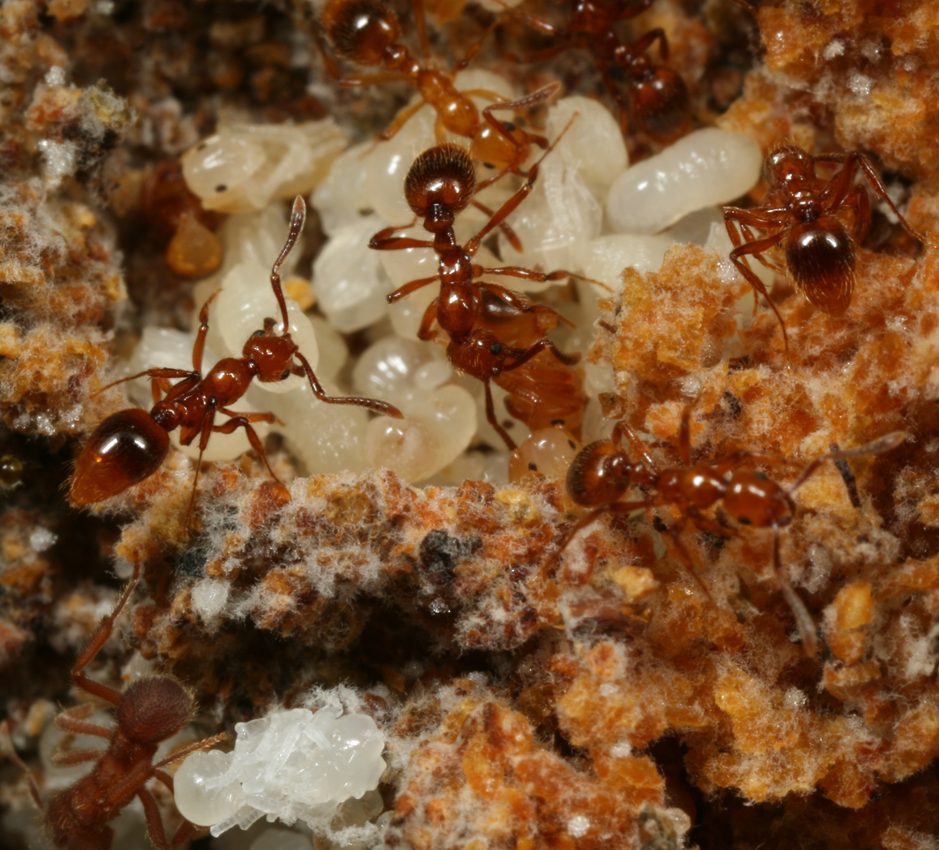
Megalomyrmex symmetochus social parasite colony with their brood in the fungus garden of Sericomyrmex amabilis farmer ant host (Credit: Heinrik De Fine Licht)
Three main parasite types infiltrate ant colonies, guest ants, thief ants, and agro-predator raiders. Though all species manipulate their host to some degree, the host’s reliance on chemical communication can leave a colony vulnerable to social parasites. While some social parasites try to match their host’s nestmate recognition code, other species rely on chemical stealth to infiltrate and integrate into the host nest.
All social parasites are armed with chemical weaponry. The guest ants live with the farmer ant colony for many years, eating its food, the fungus and some of its brood, much like other parasites do, but at a slower rate. Thief ants will invade the host colony by neutralizing host ant aggression with toxic alkaloidal venom, rendering nestmate recognition irrelevant. Thief ants eat quickly, steal some larvae and then retreat back to their nest.
In contrast, agro-predator raider ants usurp the entire fungus garden. “They chase away the host ants, eat all the brood, eat all the fungus garden and then move on to the next colony,” explains Adams. These hostile interactions can begin with a queen-to-queen fight or parasite workers can invade mature host colonies, depending on the parasite type. Regardless, the chemical code of communication plays an important role in these species interactions. The host must tolerate the presence of the parasite in order to survive the interaction and preserve a future for their colony.
Adams summarized current knowledge of social parasites saying, “So far, we know that all Megalomyrmex social parasites are using some type of alkaloid-based chemical weaponry. How toxic it is and how it impacts the host varies.” Sometimes this weaponry is used to warn the host away from the parasite, and other times it is used to poison the host. In one species, the social parasites have a muted chemical profile which may allow the guest ants to blend in with the host colony more easily. “The hypothesis is that if the parasite has a muted nestmate recognition profile, then they can sneak into the host nest undetected,” describes Adams.
Why Fungus-Growing Ants Are Parasitized
Understanding why Megalomyrmex ants target fungus-growing ants requires closer observation of both host and parasite—and a new perspective. “I’ve studied the fungus-growing ants for many years and always wondered how parasites invade the colonies” Adams shares. She continues, “There are almost 250 farmer ant species and, Megalomyrmex parasitize many different species across that lineage. So that leads to the question, why are they so vulnerable?”
The reason? “Most fungus-growing ants are wimps,” answers Adams with a laugh. “They have an interesting defense strategy–which is to play dead. They curl up in a ball and play dead if they’re attacked. That leaves them very susceptible to colony invasions,” she further expands. While insects may not be known for playing dead, fungus-growing ants and even fire ants are known for this defensive behavior. “At first you wonder, ‘how can this even exist in nature’, but as an evolutionary biologists it makes sense that this strategy has worked for the ants for millions of years.” Adams explains.
Most fungus-growing ant species don’t have soldiers or much of any way of fighting back against parasites since they have a vestigial sting and weak mandibles. Unlike leafcutter ants, who have evolved to cut leaves and therefore have large muscle-filled head capsules powering their mandibles, the majority of fungus-growing ant species feign death in hopes of being spared by invaders.
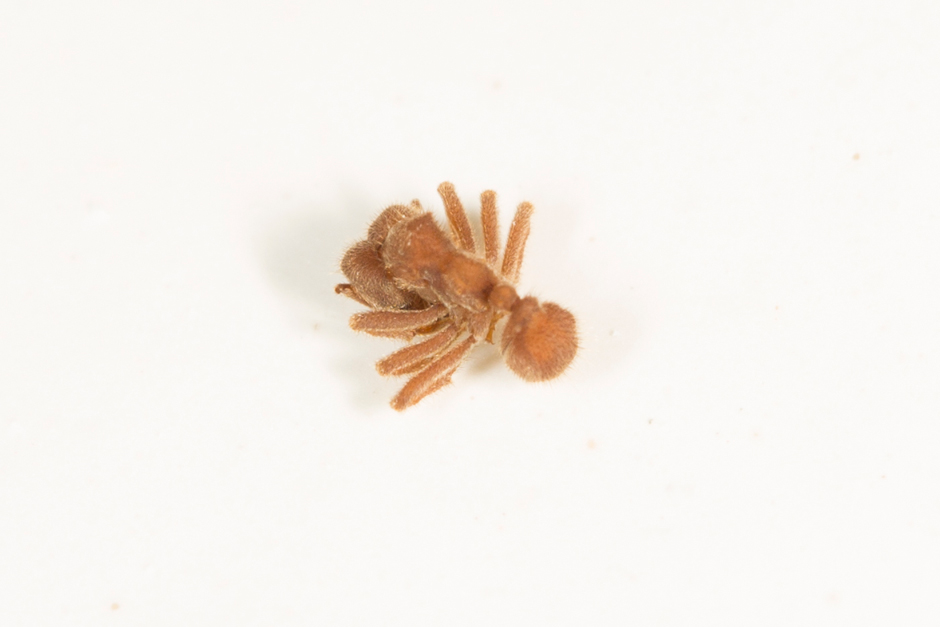
Sericomyrmex amabilis farmer ant host playing dead (Credit: Huayan Chen)
Is This Species What I Think It Is?
Throughout her research, Adams questions, “Is this species what I think it is?” This question is important to consider both for scientific identification and to consider the species’ function. For example, “Early on in my research, I was finding what I thought was a single species parasitizing different hosts. So, because of my interest in that symbiotic interactions, it’s important for me to know: are they a specialist parasite? Meaning, are they only parasitizing one species? Or are they parasitizing many? That’s a fundamental question for understanding symbiotic interactions,” Adams says.
One species parasitizing many species has different ecological consequences than a single parasite species targeting one host species. Upon closer observation, Adams found that the parasites she had discovered were not the same but were instead two different species. “At the time, the taxonomy, the keys that allow us to differentiate species, did not tell us that they were different lineages. But the molecular and venom alkaloid studies that I was doing at the time suggested they were different,” Adams elaborates. And so, a new species was named and the taxonomy was updated. This is not unusual in the world of ants, as many species remain to be discovered.
While it is easy to think of these social parasites as inherently bad, they serve an ecological function in the same way that any other species does. Hosts and parasites have evolved side-by-side, leading to favorable traits in both species as they try to combat the opposing strategies. Adams refers to this mad-dash toward improved characteristics as “the co-evolutionary arms race between the hosts and the parasites.” She explains, “In nature, symbiotic networks have many interacting species tugging at each other and understanding how they impact one another helps us appreciate how all species are connected in an ecosystem.”
Ant Outreach
Much like complex insect social structures are interconnected, Adams has found a similar connection with humans over a shared interest in ants. For Adams, the best part of her work is doing research she loves with students that share her passion. “I get to have an immediate impact on young researchers, which is a real joy and, connected to that, is a broader impact. My lab group loves outreach and talking with the public about our scientific research,” she explains.
Hoping to connect the public and ants more, Adams is in the process of creating two outreach programs that will highlight the importance of ants in ecosystems. One of these programs is called Bug Bio Badges, which is directed toward kids who can earn a badge by completing an activity. Adams plans to make the program multilingual and accessible online, so anyone can earn a badge. “This was inspired by all of us being restricted to exploring only in our backyards for many, many months,” says Adams.
Another program involves a series of ant workshops running every other year throughout Ohio. Much like nest ants are connected through a shared chemical code, Ohio has an incredible community of ant enthusiasts connected online through a forum. Adams describes the group by saying, “They’re discovering important and unique things about ants across Ohio, sharing what they’ve learned, and trading queens and colonies.” Adams hopes to have these workshops all across Ohio as a means of connecting with both the ant enthusiast community and professional naturalists that are interested in preserving nature in parks and protected areas.
Naturalists and ant enthusiasts are both invested in preserving biodiversity, and Adams hopes to study Ohio parasite populations in the future. In particular, their risk of extinction, which hasn’t been done since the 80s. Adams’ work in the Panama Canal region, is focused on a regional assessment of a parasite species that is listed as vulnerable by the IUCN. She plans to apply similar methods to Ohio ant species.
Conclusion
In the end, parasites and their hosts are equally important to the ecosystem surrounding them. Even if one were to remove a parasite from the ecosystem or expunge it from the host, the host wouldn’t necessarily be better off in the long run. “I teach a course on fungus-growing ants where I talk about Megalomyrmex ants, and I have students who tell me how to eradicate parasites because they think all parasites are bad, but I disagree–there is a lot we can learn from parasites. They’re drivers of selection, parasites are shaping populations,” Adams explains.
Many species are parasites and all organisms have at least one parasite that relies on them. Adams encourages individuals to consider, “what happens to selective pressures when you remove a parasite?” The relationship between host and parasite is a tale old as time and a lifestyle that has evolved in all organisms and interspecies relationships, meaning parasites are just as important to biodiversity and the health of an ecosystem as their host.
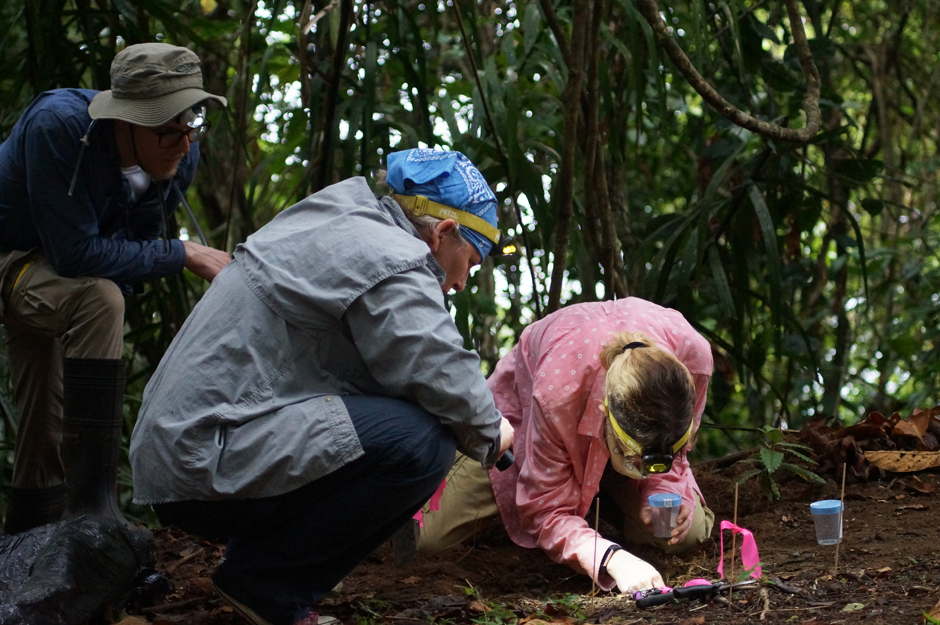
Graduate students Mathew Boot (far left) and Victoria Sadowski (far right) with Dr. Rachelle Adams collecting an ant colony in Panama (Credit: David Girbino)




Pingback: FishSens Magazine | Aquatic Chatterboxes: How Fish Communicate - FishSens Magazine
Pingback: What Is This, A Tier List For Ants? | ultimaniacy